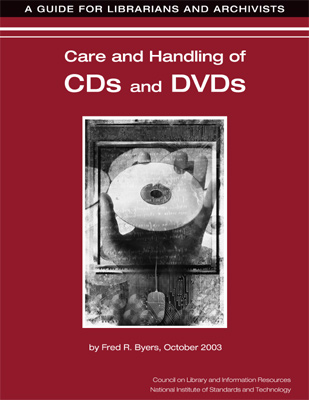Care and Handling of CDs and DVDs: A Guide for Librarians and Archivists

by Fred R. Byers
October 2003
Copublished by Council on Library and Information Resources and National Institute of Standards and Technology
Copyright 2003 by the Council on Library and Information Resources and National Institute of Standards and Technology. No part of this publication may be reproduced or transcribed in any form without permission of the publishers. Requests for reproduction should be submitted to the Director of Communications at the Council on Library and Information Resources.
National Institute of Standards and Technology
- 1.1 Scope of This Guide
- 1.2 Use of Terms: Information, Content, and Data
- 1.3 Comparative Stability of Optical Discs and Other Media
- 1.4 CDs and DVDs: Operation and Variety
2. Ensuring That Your Digital Content Remains Available
- 3.1 Polycarbonate (Plastic) Substrate Layer
- 3.2 Data Layer
- 3.2.1 Data Layer in ROM Discs
- 3.2.2 Data Layer in R Discs
- 3.2.3 Data Layer in RW and RAM discs
3.3 Metal (Reflective) Layer
- 3.3.1 Metal Layer in RW, ROM, and RAM Discs
- 3.3.2 Metal Layer in R Discs
- 3.3.3 Metal Layers in Double-Layer DVD-ROM Discs
3.4 Lacquer (Metal Protective) Layer (CDs)3.5 Optional Surface Layer
4. How Long Can You Store CDs and DVDs and Use Them Again?
- 4.1 CD-ROM, DVD-ROM Discs
- 4.2 CD-R, DVD-R, DVD+R Discs
- 4.3 CD-RW, DVD-RW, DVD+RW, DVD-RAM Discs
5. Conditions That Affect CDs and DVDs
- 5.1 Environmental Conditions
- 5.1.1 Temperature and Relative Humidity
- 5.1.2 Light Exposure
- 5.1.3 Moisture
- 5.1.4 Organic Solvents
- 5.1.5 Magnetism, X-rays, Microwaves, and Radiation
- 5.1.6 Individual Disc Storage
5.2 Surface-Handling Effects
- 5.2.1 Scratches on the Laser-Reading Side of CDs and DVDs
- 5.2.2 Scratches on the Label Side of CDs
- 5.2.3 Scratches on the Label Side of Single-Sided DVDs
- 5.2.4 Fingerprints, Smudges, Dirt, and Dust
- 5.2.5 Marking
- 5.2.6 Flexing
- 5.2.7 Application of Adhesive Labels
- 5.2.8 Disc Surface Printing
5.3 Wear from Disc Play
Appendix 1: Commercially Available CD/DVD Disc Types
Appendix 2: Optical Media Drive Types and How They Handle Different Disc Types
Tables
Table 1: Disc type, read/record type, data layer, and metal layer
Table 2: Dye type and color appearance-CD-R discs (recordable discs)
Table 3: Recommended storage parameters from different sources
Figures
Figure 1: User-removable storage-media timeline
Figures 2, 3: Layers that make up ROM discs
Figures 4, 5: Layers that make up R discs
Figures 6, 7: Layers that make up RW and RAM discs
Figures 8, 9: Two types of double-layer, single-sided DVD-ROM construction
Figures 10, 11: Two types of double-sided DVD-ROM construction
Figure 12: Printable or markable areas of the disc
National Institute of Standards and Technology
Founded in 1901, the National Institute of Standards and Technology is a nonregulatory federal agency within the Technology Administration of the U.S. Department of Commerce. Its mission is to develop and promote measurement, standards, and technology to enhance productivity, facilitate trade, and improve the quality of life.
The Information Technology Laboratory within the National Institute of Standards and Technology works with industry, research, and government organizations to make information technology more usable, secure, scalable, and interoperable than it is today. It develops the tests and test methods that developers and users of such technology need to objectively measure, compare, and improve their systems.
The Convergent Information Systems Division develops and promotes the exchange, storage, and manifestation of digital content via information technology standards, measurements, and technology that support the economy, welfare, and defense of the United States.
About the Author
Fred R. Byers has been a member of the technical staff in the Convergent Information Systems Division of the Information Technology Laboratory at the National Institute of Standards and Technology (NIST) for more than six years. He works with the Data Preservation Group on optical disc reliability studies; previously, he worked on the localization of defects in optical discs. Mr. Byers’ background includes training in electronics, chemical engineering, and computer science. His latest interest is in the management of technology: he is currently attending the University of Pennsylvania and expects to receive his Executive MasterÕs in Technology Management (EMTM) degree in 2005.
Acknowledgments
I would like to acknowledge the people who helped make this document possible. Contributions came from within the Convergent Information Systems Division at NIST, most notably and with major input from Jian Zheng and Richang Lu.
I would like to acknowledge, in particular, Jian Zheng, for his technical advice and unending enthusiasm in support of this effort. With his extensive background in optical disc manufacturing and research, he provided invaluable insight into the complexities of these discs and issues related to their usage.
Other major input from the Division came from Oliver Slattery, Gordon Lyon, Joe Navarro, and Dr. Victor McCrary. I would like to give a special thanks to Dr. Xiao Tang for suggesting this work and for providing the opportunity to assemble the information in this document, and to Paul Vassallo for his wisdom and guidance.
Others to whom I am deeply indebted for their excellent suggestions are: Janet Gertz, director for preservation, Columbia University Libraries; Christie Stephenson, director, Digital Conversion Services, University of Michigan Library; Melinda Baumann, director, Digital Library Production Services, University of Virginia Library; Catherine Murray-Rust, associate university librarian, Oregon State University; Samuel S. Brylawski, head, Recorded Sound Section, Motion Picture, Broadcasting and Recorded Sound Division, Library of Congress; Linda Tadic, director of operations, ArtSTOR, The Andrew W. Mellon Foundation; William T. Murphy, president, AVArchives Services; Ed H. Zwaneveld, innovation strategist/coach and archival system architect, INNOVAID-E; and Jim Wheeler, Tape Restoration & Archival Services.
Finally, NIST thanks the Council on Library and Information Resources, particularly Deanna Marcum, Kathlin Smith, and Amy Friedlander, for their patience and constant support from the inception of this project to the final distribution of this document. They provided much insight and cooperation on this team effort.
Fred Byers

